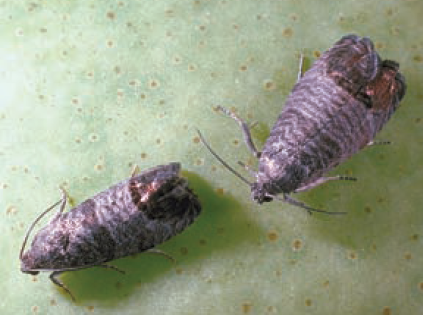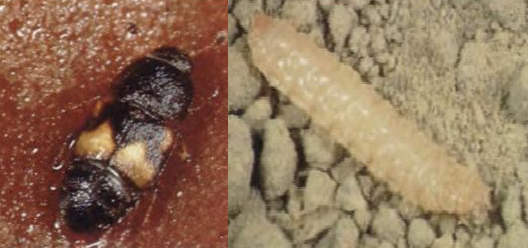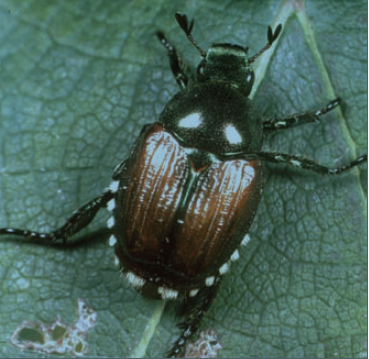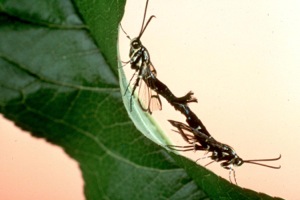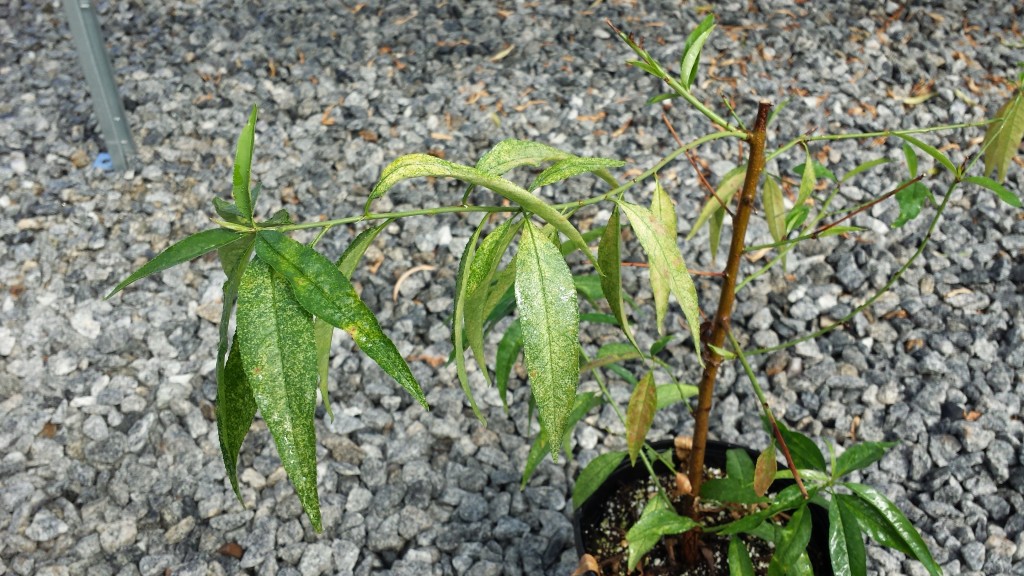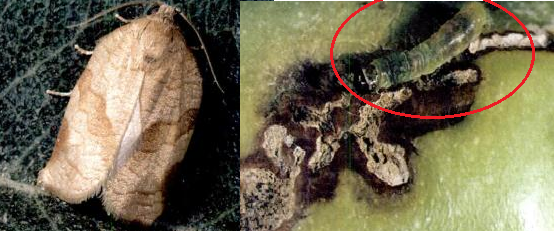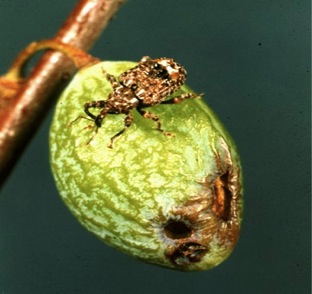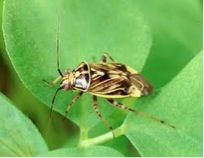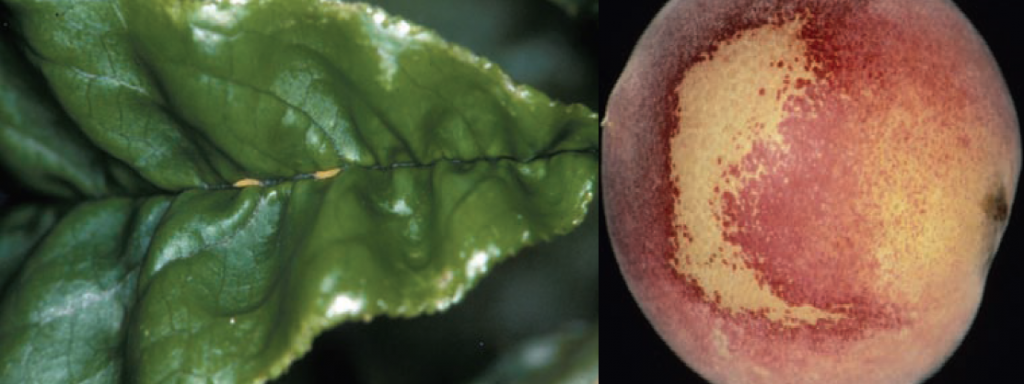Insect Pests

Common Name: Brown Stink Bug
Scientific name: Euschitus servus
Their eggs are white with a barrel shape. Nymphs are black or white with reddish marks, then they turn a yellow to brown color. The adult has a shield shape and its fully mature size is approximately ½ inch. Their color may vary between brown and grayish. Stink bugs feed on ripe and green fruit sucking fruit juices. It is easy to identify when brown stink bugs have been feeding. Dark spots and gum may exuded from the feeding points.
Image from: Jerry Payne, USDA; “Peaches,Plum, and Nectarines:Growing and Handling for Fresh Market” and “Integrated Pest Management for Stone Fruit.”
Common Name: Codling Moth
Scientific name: Cydia pomonella
The Codling moth overwinters until temperatures increase in spring. Larvae are white to pink in color with a black head. Larvae can cause damage by tunneling into the fruit. Some can even damage the seed. Adults are gray with copper semicircular spots on the underside of the wings.
Image from: “The Peach: Botany, Production and Uses”. By: Layne, R. Desmond and Daniele Bassi.
Common Name: Dried Fruit Beetles
Scientific name: Carpophilus hemipterus
Larvae are slim, white in color and brown heads. Adults are black, around 3 mm long, and have reddish legs and short wings. Dried fruit beetles are attracted to injuries previously created on trees or fruit, and very ripe fruit.
Image from: “What´s Bugging me?: Identifying and Controlling Household Pest in Hawaii.”
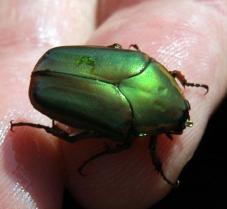
Common Name: Green June Beetle
Scientific name: Cotinis nitida
The grub stage is harmless to the trees. The larvae are white. The Green June beetle has a green velvet to green metallic color with bronze stripes. They typically feed on ripened fruit.
Image from: UGA Center for Urban Agriculture. Green June Beetles.
Common Name: Japanese Beetle
Scientific name: Popillia japonica (Newman)
Japanese beetle larvae are white. Adults have a metallic green color with copper colored wings and are oval in shape. Japanese beetles feed from the foliage and fruit. Their damage can be identified by lacelike defoliation.
Image from: “The Peach: Botany, Production and Uses”. By: Layne, R. Desmond and Bassi, Daniele
Common Name: Mating Lesser Peachtree Borer
Scientific name: Synanthedon pictipes
Eggs are oval, with a reddish or brown color, and are usually found on trunks, debris, or near the soil line. Larvae are white or creamy in color, with a dark head. Adults have a metallic blue color with orange stripes with transparent wings. Adult length varies from about 40 mm (males) to 30 mm (females). The main damage caused by the larvae is feeding on the trunk and bark. Damage on young trees can produce tree death.
Image from: Ted Cottrell, USDA-ARS.
Common Name: Mites: Two Spotted Spider Mite and European Red Mite
Scientific name: Tetranychus urticae & Panonychus ulmi
Mites feed on foliage where they cause the most damage. Mites have several hosts, with peach trees being one of them. However, peaches have more tolerance to mite damage than many other deciduous fruit trees. When the problem becomes severe, plants can experience severe defoliation which can produce poor scaffold development.
Image from Dario Chavez. Peach Research and Extension Specialist. University of Georgia.
Common Name: Obliquebanded Leafroller
Scientific name: Choristoneura rosaceana
Larvae are yellowish to green in color, approx. 30 mm long. They have black to brown head. Adult length is approximately 11 mm for males and 14 mm for females. O. leafroller feeds from leaves and fruit surface.
Image from: “Integrated Pest Management for Stone Fruits”
Common Name: Oriental Fruit Moth
Scientific name: Grapholita molesta (Busk)
The Oriental fruit moth was introduced in 1913 from Japan and has become one of the major problems in fruit trees such as peach and nectarine. Most of the damage is caused by the larvae feeding on succulent growth. Larvae on the first stage are white and on the last stages become reddish in color. Larvae damage can be identified by wilted leaves and the presence of sawdust like waste. The Oriental fruit moth can also cause gumming and, in further stages, the larvae can tunnel from the peduncle into the fruit which may cause significant fruit damage. Adults are grayish black and approximately 6-7 mm long.
Image from: “The Peach: Botany, Production and Uses”. By: Layne, R. Desmond and Bassi, Daniele.
Common Name: San Jose Scale
Scientific name: Diaspidiotus perniciosus
San Jose scale is a major problem on fruit trees such as peaches, nectarines, cherries, pears and more. Their damage is located on branches, shoots, leaves and fruit, where nymphs and adults feed by sucking the plant juices. Most of the life of San Jose scale is protected by an armor, except in the first stage of nymph and adult males. For adult female identification look for round (1.6-2 mm) grey flat structures with raised protection in the middle. Males are small and have yellow wings.
Image from: ”The Peach: Botany, Production and Uses”. By: Layne, R. Desmond and Bassi, Daniele.
Common Name: Tarnished Plant Bug
Scientific name: Lygus lineolaris
Eggs are small (1 mm wide). The early stage of nymphs are yellowish green in color. The late stages are green without wings. Adults are about 6 mm long, with yellowish brown heads. Their anterior wings are reddish brown in color. The tarnished plant bug sucks the plant juices and also can be a vector that transmits diseases.
Common Name: Thrips
Scientific name: Thysanoptera
Thrips can be a problem where weather conditions are dry, but more often they become problematic in rainy areas. Thrips are small and slim with a cigar shape. They feed on flowers and on immature fruit. They leave behind silver scars on the surface of the stonefruits.
Image from: J.A. Payne, UGA Bugwood.

